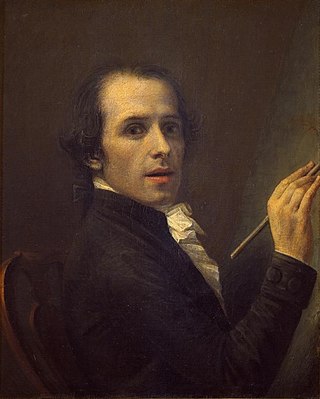
Antonio Canova was an Italian Neoclassical sculptor, famous for his marble sculptures. Often regarded as the greatest of the Neoclassical artists, his sculpture was inspired by the Baroque and the classical revival, and has been characterised as having avoided the melodramatics of the former, and the cold artificiality of the latter.

Jacques-Louis David was a French painter in the Neoclassical style, considered to be the preeminent painter of the era. In the 1780s, his cerebral brand of history painting marked a change in taste away from Rococo frivolity toward classical austerity and severity and heightened feeling, harmonizing with the moral climate of the final years of the Ancien Régime.

François Boucher was a French painter, draughtsman and etcher, who worked in the Rococo style. Boucher is known for his idyllic and voluptuous paintings on classical themes, decorative allegories, and pastoral scenes. He was perhaps the most celebrated painter and decorative artist of the 18th century.

Figurative art, sometimes written as figurativism, describes artwork that is clearly derived from real object sources and so is, by definition, representational. The term is often in contrast to abstract art:
Since the arrival of abstract art the term figurative has been used to refer to any form of modern art that retains strong references to the real world.
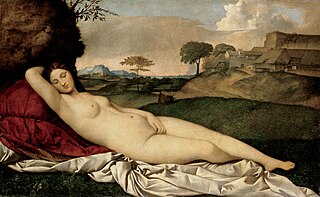
The Sleeping Venus, also known as the Dresden Venus, is a painting traditionally attributed to the Italian Renaissance painter Giorgione, although it has long been usually thought that Titian completed it after Giorgione's death in 1510. The landscape and sky are generally accepted to be mainly by Titian. In the 21st century, much scholarly opinion has shifted further, to see the nude figure of Venus as also painted by Titian, leaving Giorgione's contribution uncertain. It is in the Gemäldegalerie, Dresden. After World War II, the painting was briefly in possession of the Soviet Union.
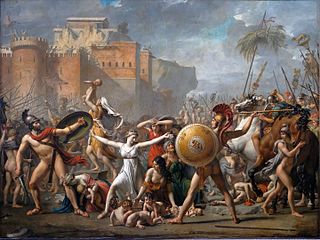
The Intervention of the Sabine Women is a 1799 painting by the French painter Jacques-Louis David, showing a legendary episode following the abduction of the Sabine women by the founding generation of Rome.

Realism in the arts is generally the attempt to represent subject matter truthfully, without artificiality and avoiding speculative and supernatural elements. The term is often used interchangeably with naturalism, although these terms are not synonymous. Naturalism, as an idea relating to visual representation in Western art, seeks to depict objects with the least possible amount of distortion and is tied to the development of linear perspective and illusionism in Renaissance Europe. Realism, while predicated upon naturalistic representation and a departure from the idealization of earlier academic art, often refers to a specific art historical movement that originated in France in the aftermath of the French Revolution of 1848. With artists like Gustave Courbet capitalizing on the mundane, ugly or sordid, realism was motivated by the renewed interest in the common man and the rise of leftist politics. The realist painters rejected Romanticism, which had come to dominate French literature and art, with roots in the late 18th century.
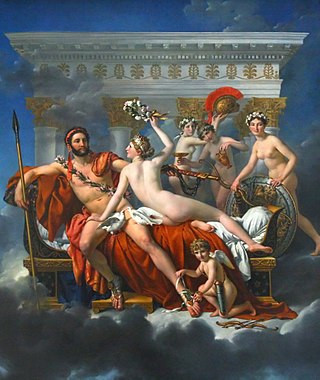
Marie Lesieur, known as Lesueur, was a French ballet dancer.

Leonidas at Thermopylae is an oil-on-canvas painting by French artist Jacques-Louis David. The work currently hangs in the Louvre in Paris, France. David completed the massive work 15 years after he began, working on it from 1799 to 1803 and again in 1813–1814. Leonidas at Thermopylae was purchased, along with The Intervention of the Sabine Women, in November 1819 for 100,000 francs by Louis XVIII, the king of France. The piece depicts the Spartan king Leonidas prior to the Battle of Thermopylae. David's pupil Georges Rouget collaborated on it.

Le Suicidé is a small oil painting by Édouard Manet completed between 1877 and 1881. The painting has been little studied within Manet's oeuvre, as art historians have had difficulty finding a place for the work within the development of Manet's art.
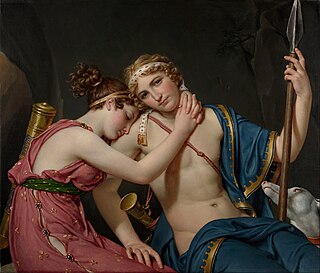
The Farewell of Telemachus and Eucharis is a painting from 1818 by Jacques-Louis David, now in the J. Paul Getty Museum in Los Angeles, California. Painted during David's exile in Brussels, it was purchased by the Count von Schönborn-Wiesentheid. It depicts Telemachus and Eucharis, two characters in François Fénelon's 1699 novel Les Aventures de Télémaque, inspired by Homer's Odyssey. The artist's last painting of a couple from mythology, it is a pendant painting to his Love and Psyche.

Love and Psyche or Cupid and Psyche is an 1817 painting by Jacques-Louis David, now in the Cleveland Museum of Art. It shows Cupid and Psyche. It was produced during David's exile in Brussels, for the patron and collector Gian Battista Sommariva. On its first exhibition at the museum in Brussels, it surprised viewers with its realist treatment of the figure of Cupid. Critics generally saw the painting's unconventional style and realistic depiction of Cupid as proof of David's decline while in exile, but art historians have come to see the work as a deliberate departure from traditional methods of representing mythological figures.

The Anger of Achilles is an oil-on-canvas painting of 1819 by the French artist Jacques-Louis David. It is in the collection of the Kimbell Art Museum, Fort Worth, Texas.
Michel Ghislain Stapleaux was a Belgian portraitist and history painter. He was the husband of the flower painter Louise Schavije and won two gold medals for history painting, in the competitions at Brussels in 1822 and Antwerp in 1823.

Psyche Abandoned is a c. 1795 painting by Jacques-Louis David, now in a private collection. It shows Psyche as a crouching female nude in profile against a blue sky with a hill in the background. She stares at the viewer with an expression of loss, pain, and betrayal. Thought to have been painted during David's imprisonment during the French Revolution, it dates from either 1794 or 1795. Vertical in format, it diverges from the academic conventions for representing the female nude.

Marie-Joséphine-Angélique Mongez, née Levol was a French Neoclassical artist. She studied under Jean-Baptiste Regnault and Jacques-Louis David and produced historical paintings. She was the first woman to become a history painter during the post French Revolution era. Mongez started studying under Jean-Baptiste Regnault in the early 1790s and then, after mastering the basics, she became a pupil of Jacques-Louis David, who at the time was one of the leaders of the Neoclassical movement in France. Her work was featured at a number of salons between 1802 and 1827. Some male reviewers criticized her for including depictions of nudity in her work.

Venus and Mars is an oil painting on canvas painted in the 1570s by the Italian Renaissance artist Paolo Veronese.

In 1635, Peter Paul Rubens created Venus and Adonis, now in the Metropolitan Museum of Art, New York. He followed the mythological story in the Metamorphoses by Ovid, inspired from his love of classical literature and earlier depictions of this scene. This oil on canvas painting shows Venus accompanied by Cupid, embracing and pulling Adonis before he goes off to hunt. The artist uses specific colors, detail and strong contrast between light and dark to depict a dramatic and emotional scene. At the time Rubens created the painting, the mythological story of Venus and Adonis was popular in Renaissance and Baroque court art. Rubens was clearly inspired by the many existing depictions of this scene, in particular the famous Titian composition of the same name, of which there are numerous versions. This depicts the same moment of Adonis leaving Venus to hunt, despite her pleas to stay. He is killed later in the day.

Venus Verticordia (1864–1868) by Dante Gabriel Rossetti is a semi-nude depiction of the goddess Venus, portrayed as a young woman with a golden halo and flowing auburn hair, surrounded by pink flowers in a dark, lush green garden. Her left breast is visible, the right obscured by the golden apple she holds in her left hand. In her right hand she holds an arrow, the point directed towards her own heart, and on which rests a small yellow butterfly. Other similar butterflies ring the halo surrounding her head, and another sits on top of the apple she holds.

The historical evolution of the nude in art runs parallel to the history of art in general, except for small particularities derived from the different acceptance of nudity by the various societies and cultures that have succeeded each other in the world over time. The nude is an artistic genre that consists of the representation in various artistic media of the naked human body. It is considered one of the academic classifications of works of art. Nudity in art has generally reflected the social standards for aesthetics and morality of the era in which the work was made. Many cultures tolerate nudity in art to a greater extent than nudity in real life, with different parameters for what is acceptable: for example, even in a museum where nude works are displayed, nudity of the visitor is generally not acceptable. As a genre, the nude is a complex subject to approach because of its many variants, both formal, aesthetic and iconographic, and some art historians consider it the most important subject in the history of Western art.






















